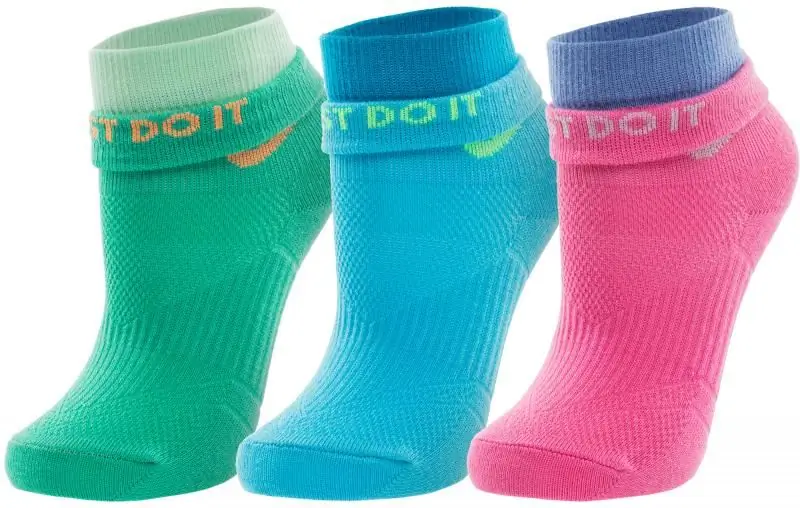
Table of contents:
- Author Bailey Albertson [email protected].
- Public 2023-12-17 12:53.
- Last modified 2025-06-01 07:32.
How to clean or wash your backpack

A backpack is an essential attribute of school and student fashion. It is not uncommon for adults to use this shoulder bag, having appreciated its convenience compared to bags and briefcases. Like all things, the once stylish piece gradually gets dirty. How to clean the backpack from dirt and return it an attractive appearance, it does not hurt everyone to know.
Content
-
1 Can the backpack be washed
1.1 How often to wash
-
2 Preparing for washing
- 2.1 How to remove greasy stains and stubborn dirt
- 2.2 Removing ink marks
- 2.3 Chewing gum and plasticine
- 2.4 Bad smell
- 3 Wet express cleaning from dust and debris
-
4 Ways to wash your backpack
- 4.1 Machine wash
-
4.2 Hand wash
4.2.1 Video: Hand-washing your schoolbag
- 4.3 Wet cleaning with soapy foam
- 5 How to dry a backpack
Can the backpack be washed
Manufacturers often do not recommend doing this. Most of the models have a special water-resistant impregnation, which is gradually washed out during washing. The guaranteed protection of the contents of the backpack from rain and snow is lost, the fabric changes its appearance, becomes less dense. To answer the question about washing, you need to study the label of the product, which indicates the parameters for care. It is located inside the backpack, most often in the largest compartment near one of the side seams. If it states that washing is allowed, feel free to act. Just follow the temperature regime and other recommendations. If washing is prohibited, to keep the look of your expensive, exclusive or personalized travel backpack, it is best to use a dry cleaning service.

The product label shows the manufacturer's recommended care parameters
How often to wash
There are two extreme options: not to do it at all, or, conversely, very often. In the first case, the backpack accumulates dirt, which becomes more difficult to remove over time, and in the second it wears out faster: the fabric is rubbed, the dye is washed out, sometimes deformation occurs. Ultimately, the product loses its attractive appearance in a short period of time. Therefore, it is necessary to wash a backpack as it gets dirty: school, city and any that is used daily - once every 2-3 months, tourist - 1-2 times a year.
Preparing for washing
To save time and effort, to get the best result will help the correct preparation of the product:
- Remove all contents from the backpack. A banknote forgotten in a secret pocket and washed will not add joy. And a wet notebook can make your work much more difficult if ink runs out and stains the fabric. So check your pockets carefully.
- Disconnect removable parts, unfasten handles, belts, remove the rigid frame, if possible. A lightweight backpack is easier to wash.
- Shake the product out thoroughly. If possible, vacuum the inside using a soft nozzle. Clean the outside of dust and dirt with a brush.
Since normal washing usually does not deal with stains, they must be removed beforehand. To do this, you can use stain removers - Vanish, Selena Pyatnol, Antipyatin soap, etc. Most of the products are applied directly to the dirt and left for 5-10 minutes, and then the product is washed. When choosing a stain remover, pay attention to what type of fabric it is applicable to, whether it is suitable for your backpack. Strictly follow the instructions for use and safety recommendations: with some products, you can only work with gloves.
How to remove greasy stains and stubborn dirt
If a child hid a half-eaten pie in a backpack when the teacher entered the class, do not scold him. There are many proven ways to get rid of the stain.
-
Sprinkle fresh stains with salt, starch or talcum powder. They have good absorbent properties. Use your fingers to lightly rub the selected product into the fibers of the fabric and leave for 1-2 hours. If the substance is absorbed, add more. Remove residues, rub off the stain.

A pack of salt on a blackboard Salt absorbs fresh dirt well
- If it's already dry, lightly dampen it and apply salt or mustard powder. You can do both. Drop water on top to make a gruel. Leave to dry completely, then brush and wash.
-
In case of severe pollution, ammonia will help out. Dissolve 1 tablespoon in a glass of water and apply to the stain using a cotton pad. Leave it on for 2-3 hours. If the fabric dries up, re-moisten with the solution and then wash.

Ammonia Strong dirt can be removed with ammonia
- Any dishwashing detergent copes well with greasy stains. Apply it on the stain, wait 5-10 minutes, brush off and then rinse with water. Repeat the procedure if necessary.
-
Use laundry soap to remove greasy and stubborn dirt. This can be done in two ways:
- rub the dirty areas with a dry piece before washing and leave for 5 minutes;
-
moisten the product and lather thoroughly, and wash after 2-3 hours.

Laundry soap and shavings from it Use laundry soap to remove greasy stains
Removing ink marks
It is easier to remove a fresh stain, but you will have to tinker with an old one. This can be done most effectively with alcohol or vodka:
- Moisten a cotton pad abundantly with alcohol and apply to the dirt. If it's old, let it sit for 5 minutes.
- Blot with cotton wool. Some of the dissolved ink will remain on it. Do not rub the stain; this will only smear it more.
- Repeat the procedure. Gradually, the trace will decrease and disappear altogether. But the process is long and time consuming.
Chewing gum and plasticine
Do not try to scrape or scrape off. The effect will be exactly the opposite: some part can be removed from the backpack, but the remainder will go deep into the fibers and remain there forever. The easiest way is to freeze:
- Pack your backpack in a plastic bag and place it in the freezer for several hours.
- After the gum (or plasticine) is completely frozen, it can be easily removed from the fabric.
- A greasy stain will remain on the material from plasticine, which can be removed using any of the above methods.
Bad smell
Washing is usually sufficient to eliminate any unpleasant odors. But to be sure, you can soak your backpack for 15-20 minutes in a vinegar solution: half a glass for 5-6 liters of water. Sometimes the product smells unpleasant after washing. Do the same procedure. Vinegar effectively kills all odors and completely disappears during drying.
If the backpack is basically clean and the only problem is the smell, you can do without washing. Place inside each compartment a small linen bag containing salt or activated charcoal tablets, which can be purchased at the pharmacy. Close the zippers and leave for 1-2 days. Activated carbon and salt absorb odors well.

Activated carbon absorbs odors well
Wet express cleaning from dust and debris
If dust, small debris has accumulated inside, and there is no time for a full cleaning at all, you can quickly put your backpack in order as follows:
- Tap the body with your palm so that small debris, which often accumulates in the seams, ends up at the bottom of the backpack.
- Open your pockets. Fold the top of the main compartment outward as far as possible.
- Turn the garment upside down and tap on it. It is better to do this on the street or over a wide basin, bathroom.
- Vacuum your backpack if possible. To avoid damaging the lining fabric, use a soft furniture attachment.
-
Wipe the inside with a damp cloth, if the backpack is school, it is better to take an antibacterial one. Take extra care along the seams, if necessary, change napkins as they become dirty. It is important that the fabric does not become very wet, otherwise the backpack will have to be dried, and this will take time.

antibacterial wipes Wet wipes will remove dust and germs inside your backpack
-
External cleaning depends on the material: if the upper is made of leather or moisture-resistant textiles, it can also be wiped with a damp cloth or cleaned with a foam spray, which is sold in shoe care departments. For quick cleaning of natural fabrics that get wet, use only dry cleaning with a cloth brush.

foam shoe cleaner The foam can be used to clean not only suede, but also leather, leatherette, and textiles
- Leave the backpack with open compartments to breathe for a few minutes.
- If necessary, treat the surface with a caring spray or cream (natural leather and suede will be grateful for your care).
-
Open windows or leave the room to the open air, spray the backpack with a water-repellent spray. Wait a bit for the smell to go away. This treatment is recommended to be performed several times a year.

impregnation for shoes The impregnation protects the product not only from moisture. but also from dirt
Ways to wash your backpack
At home, any backpack can be cleaned in one of the following ways:
- machine wash;
- handwash;
- dry cleaning or using foam (suitable for all types, especially for products made of natural and artificial leather).
Machine wash
The method is suitable for soft backpacks that do not have metal or plastic frames and orthopedic pads:
-
Close all zippers, buttons, Velcro, latches. This will protect the product from distortion and deformation.

Soft backpacks Close zippers, buttons, Velcro on your backpack before washing.
-
Use a dedicated laundry bag. This will protect metal and plastic fittings from scratches. If any part comes off, such as a sticker or a decorative part of the zipper, it will also remain inside the bag and will not clog the drain hose.

Plastic hardware on the backpack In order not to damage the accessories during machine wash, it is better to put the backpack in a special bag
-
Set the mode according to the manufacturer's instructions on the label. If it is lost, select a delicate wash cycle, wool or silk. Jeans and polyester Maximum washing temperature - 40 to C, and the optimum - 20-30 about C. Spin do not use.

Soft backpacks in a drum machine It is better to wash backpacks in a machine, choosing a delicate mode without spinning
- Choose liquid detergents. In cool water, they dissolve faster and completely, are easier to wash out and do not leave ugly streaks on the product. If using powder, take a little less than the manufacturer recommends.
- Be sure to add an extra rinse.
Handwash
Unlike a machine, this is a more gentle option. Therefore, it is applied to all products that can be washed in general, including for the care of tourist or frame backpacks.

Only hand wash is suitable for the frame backpack
Operating procedure:
- Fill the bath with warm water - about 10 cm in height, so that the backpack is completely immersed in the water.
- For washing, use any detergent, but preferably liquid. There are special detergents for travel backpacks on sale.
- Submerge the product in water to moisten it.
- Using a brush, sponge or just with the palm of your hand, apply the detergent to its surface, rub lightly. If the dirt is heavy, leave to soak for 20-30 minutes. The term can be increased up to two hours, but not longer, since water negatively affects any fabric.
- Poke the backpack up and down. You can rub it again with a brush or sponge if the dirt is not completely removed.
- Rinse the product thoroughly with a stream of water from the shower.
To protect the backpack from moisture, during subsequent use, you can additionally treat it with a moisture-repellent impregnation, for example, Nikwax TX. Direct. To do this, fill the bath with about 6 liters of water again, add 50 ml of the product, stir well and immerse the product in the solution for 10 minutes, and then rinse in cold water.
Video: hand washing a schoolbag
Wet cleaning with lather
The method is suitable for all products, including backpacks made of natural and artificial leather.

Leather backpack can be cleaned of dirt with foam
Operating procedure:
- Dilute the detergent in a bowl and whisk well.
- Using a sponge, grab the foam without touching the liquid and apply to the surface of the backpack.
- Scrub the area with the heaviest dirt.
- And also with a sponge, rinse the product with clean water, remove the remaining foam.
How to dry a backpack
Since the product is not wrung out or twisted, water will flow from it immediately after washing. Therefore, at the first stage of drying, it is better to place it on the grate above the bath. You can use different options:
- put on the dryer, and substitute a basin for the flowing water from below;
- put a stool on the bottom of the bathtub, and put a backpack on it;
- take out to fresh air (the process will take less time).
When most of the moisture is gone, you can dry in two ways:
-
A backpack, which can deform when suspended, is best placed vertically on the dryer, opening the zippers, pushing the compartments as wide as possible so that air can penetrate inside.

Outdoor backpack Open the compartments wide during drying to let in fresh air
-
Hanging, for example, by the handle or shoulder straps, you can dry textile school or tourist backpacks made of synthetic materials.
But in this case, while the fabric is still very damp, it is better not to open the zippers so that there is no distortion and stretching. When the outside of the backpack is dry, open all compartments and pockets to dry the inside.
You can speed up the process with a fan heater. Direct a stream of air towards the backpack: the breeze will disperse the water vapor accumulated near the wet product, and it will take less time to dry.

If it is not possible to dry the backpack outdoors, you can use a fan
To care for different types of backpacks, it is not necessary to go to dry cleaning. You can remove stains, wash the product and remove unpleasant odors yourself.
Recommended:
How And How To Wash Blood From Clothes And Linen At Home, Ways Of Washing By Hand Or In A Washing Machine + Photos And Videos

How to effectively remove fresh or old blood stains on clothes made from different fabrics? We apply folk advice in practice, using materials at home
How To Wash Sneakers In The Washing Machine And By Hand, Including White, The Nuances Of Washing + Photos And Videos

Sneakers are shoes that are comfortable and easy to wear for a walk, nature and even a date. If they get dirty, it doesn't matter. You can always wash them
How To Wash Socks At Home, Especially For Different Materials, Manual And Machine Methods, How To Wash White Socks

How to wash white, black and colored socks. Effective ways to remove stains by hand and in a washing machine. How to wash children's socks from various dirt
How To Wash Sneakers In A Washing Machine (including An Automatic Machine) Correctly, And Then Dry Your Shoes

Tips for washing sneakers in a washing machine step by step. Nuances, features, use of special products, drying rules
How And At What Temperature To Wash Clothes For Newborns, Detergents For Washing Baby Clothes In A Washing Machine And By Hand

Basic rules for washing clothes for newborns. Requirements for the composition and effect of children's laundry detergents. How to machine wash baby clothes and by hand
